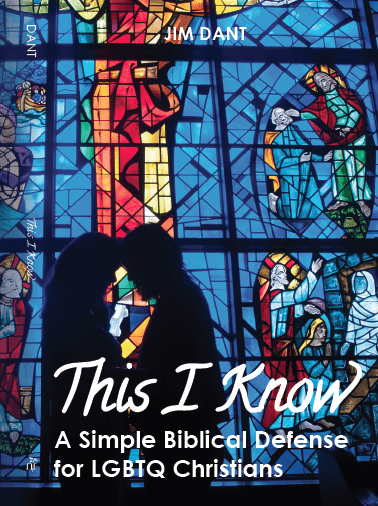 By John D. Pierce, Executive Editor of Nurturing Faith Journal & Bible Studies and Publisher of Nurturing Faith Books
By John D. Pierce, Executive Editor of Nurturing Faith Journal & Bible Studies and Publisher of Nurturing Faith Books
No issue impacts congregational and denominational life today more than how to include or exclude LGBTQ persons. Some churches and Christian organizations try to ignore the subject to avoid division — but it doesn’t go away.
Highly conservative groups solidly condemn same-sex relationships as sin and make no space for such persons or for any new light on the subject. Some liberal faith traditions are welcoming, affirming and inclusive of LGBTQ persons.
However, many Christians struggle to find a way to respond with a desire to be both biblically faithful and deeply compassionate — especially when a beloved family member expresses both same-sex orientation and deep devotion to Christ.
Fewer and less-direct Bible verses exist for addressing this issue than the numerous ones used to claim biblical justification for slavery and the subjugation of women. Yet these few so-called “clobber verses” used to condemn LGBTQ persons are often applied with little regard for context.
In a pastoral response to LGBTQ Christians and those seeking to affirm them compassionately, pastor Jim Dant of First Baptist Church of Greenville, S.C., has written a brief, but not shallow, “survival manual” that digs into the biblical case.
This I Know: A Simple Biblical Defense for LGBTQ Christians is now available from Nurturing Faith — in print for $12, including shipping, or as a digital download for $9.99. Orders may be placed at this link.
Also, book signings have been set for next month in San Francisco (Feb. 6, Dog Eared Books), Greenville, S.C. (Feb.11, First Baptist Church and Feb. 15, M. Judson Booksellers), and Macon, Ga. (Feb. 22, Barnes & Noble). Other dates and locations are being sought.
The following conversation gives insights into the book’s origin and purpose, and the author’s approach.
NFJ: People are already saying about your book: “This is really needed.” What void does it fill?
JD: There are a lot of good books out there that delve deeply into the theology and language of the biblical verses cited to condemn homosexuality. But most are relatively thick, necessarily scholarly and loaded with footnotes.
What I kept hearing from the average person in the pew, and in LGBTQ support groups and gatherings was: “We need something short, pocket-sized and simple. Those who stand against us speak in bumper-sticker phrases that we need to be able to counter and combat.”
So I resisted the temptation to write for my seminary professors and chose to write for that 22-year-old lesbian in the pew that hasn’t been to seminary as well as for the lifetime Baptist grandmother who is trying to reconcile her love for her gay son with these select Bible verses. It is a short, simple, credible theology for the average person.
NFJ: How much did this book come out of your pastoral experiences?
JD: The whole book was birthed out of pastoral experience. On one level, the book is a pastoral response to LGBTQ persons who need to validate — with a credible understanding of scripture — their faith practice and experience.
It is also a response to friends and family of LGBTQ Christians who desire to defend the persons they love. And it is truly an attempt to help the faithful who oppose the inclusion of LGBTQ persons to understand the Bible differently. It is pastoral in that it addresses the needs of these audiences.
At another level, each brief chapter is divided into four sections: the challenge posed to LGBTQ persons, the short “bumper-sticker” response to the challenge, a short theological explanation of the response, and finally a section I call “Just for Fun.”
This final section of each chapter is an anecdote from a real conversation I’ve had with regard to that chapter’s challenge. It was shaped in pastoral conversation.
NFJ: Your congregation hosted the San Francisco Gay Men’s Chorus last year. It was widely hailed as a significant spiritual experience for many. How so?
JD: Anytime we face and overcome our fears, it is a significant moment. The San Francisco Gay Men’s Chorus (SFGMC) and our congregation both had to acknowledge and overcome fears to make this event happen.
The church had fears around community reaction and the SFGMC just feared Baptists in the South. At the core of all these fears — in my estimation — is the fear of rejection: by our communities, by each other — and perhaps by God?
Overcoming fear is exhilarating. It’s also a significant moment when reconciliation is achieved.
We had no idea how many would be in the congregation that evening. I met with the chorus in our fellowship hall about an hour before the concert. One member asked how many we expected to attend.
I was honest. I told them there may be only about 100 in the sanctuary or it could be filled to its capacity of 1,400. I was expecting something comfortably in between.
When we entered the sanctuary an hour later, it was filled to capacity. Chairs had been brought in and people were standing at the walls. The congregation rose for a standing ovation as the SFGMC entered the room.
The chorus members began crying. The congregation cried too. And the concert hadn’t begun yet. It was a moment of unplanned, Holy Spirit reconciliation.
And finally, the concert itself was rich in content. No limit was put on the choir. They did pop tunes (like “Celebrate” and “The Age of Aquarius”), sacred music (like “Amazing Grace” and “Nearer My God to Thee”) and a couple of drag/LGBTQ satire tunes (Patsy Cline and “Color Out of Colorado”). A testimony was shared by Dr. Tim Seelig, artistic director for the chorus, who has written the foreword for the book based on that experience.
In essence, we cried and laughed and listened together. As one parishioner put it, it was the closest thing to a revival he had been to in decades.
NFJ: What approach do you take to the Bible in this book — and does Jesus, who often gets ignored in the Christian debate over LGBTQ persons, make an appearance?
JD: I truly believe I am more “conservative” in my interpretation of scripture than my so-called conservative critics. I take seriously the culture, language and theological context in which the text was written. I fight hard against the contemporary cultural influences that might taint my reading of texts.
The average reader takes great liberty with the text when they simply read a verse in its 21st-century translation and apply present political and social understandings to those words. Marriage in the 21st century is nothing like marital structures in earlier centuries.
Verses that most persons quote in opposition to homosexuality had nothing to do with consensual same-sex relationships between adults during biblical times. Even the present use of the word “abomination” (hear this with all the angry, red-faced preacher connotations you can put on it) is far from the meaning of the word in Levitical law.
I approach the Bible with an honest and serious eye toward a historically accurate interpretation. But, just as important, I approach the Bible with the need for theological consistency.
Put simply, I’ve never understood how some Christians align their self-righteous, judgmental, hate-filled rhetoric with the person of Jesus and the unconditional, unending, boundless reach of God’s love and grace.
Or how Christians who believe they are “saved by grace” suddenly impose “law” on other persons. It just isn’t a theologically consistent reading and application of the biblical text.
So, yes, Jesus appears in the book, and I hope readers begin to reshape and understand their views of God through the person of Jesus — and that we all deal with some very telling words of Jesus.
Director of the Jesus Worldview Initiative at Belmont University in Nashville, Tennessee and former executive editor and publisher at Good Faith Media.


